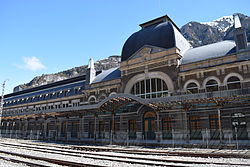Estación Internacional de Canfranc
|
Canfranc
|
|
|---|---|

The station in July 2015.
|
|
| Location | Spain |
| Coordinates | 42°45′02″N 0°30′53″W / 42.75065°N 0.51460°W |
| Elevation | 1,195 metres (3,921 ft) |
| Line(s) |
|
| Construction | |
| Structure type | At-grade |
| History | |
| Opened | 11 July 1928 |
Canfranc International Railway Station (Spanish: Estación Internacional de Canfranc) is a former international railway station in the village of Canfranc in the Spanish Pyrenees, at one end of the Somport railway tunnel which carried the Pau–Canfranc railway under the Pyrenees. Opened in 1928, the main building is 240 metres (790 ft) long and has 365 windows and 156 doors.
Construction of the Somport railway tunnel was inaugurated on the French side on 12 July 1912, and after delays in its construction due to World War I, completed in 1915.
Spanish project engineer Ramírez de Dampierre began construction of the station in 1923, and it was formally opened on 18 July 1928, in the presence of King Alfonso XIII of Spain and the president of the French Republic Gaston Doumergue. The station has 365 windows, and platforms over 200 metres (220 yd) long. The large size—the second largest station in Europe, known at the time as the "Titanic of the Mountains"—and extensive infrastructure were necessitated in part by the need to transfer all transiting passengers, baggage and freight between Spanish and French trains, because the French rail standard gauge of 1,435 millimetres (4 ft 8.5 in) was incompatible with the Spanish gauge of 1,672 millimetres (5 ft 5.8 in) at the time and hence prevented through-traffic. This transformed a simple customs-control exercise into a lengthy logistics exercise. The site includes a large locomotive depot, two sheds for the transshipment of freight between French and Spanish trains, various other outbuildings and a resultant extensive layout of tracks. Part of the station was considered French territory; a school was established in the village for the children of French staff.
During the Spanish Civil War, Franco had the tunnels sealed on the Spanish side to prevent arms smuggling. But due to the Franco-Spanish international convention under which it was built, the station remained open during World War II. The Spanish authorities came to an operational agreement with the Nazi German Wehrmacht authorities, with freight-trains carrying mined tungsten north and French grain plus trans-shipped Swiss gold south; passenger services also continued, providing an escape route into Spain for some Jews and Allied soldiers.
...
Wikipedia
